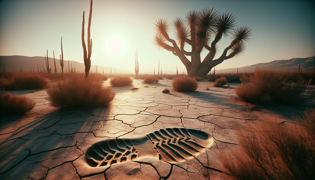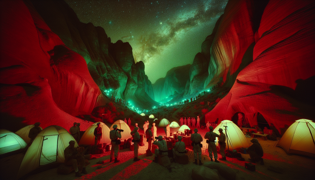Introduction
Under the relentless sun of the Colorado Desert, the windswept dunes of Twentieth Palms guard their deepest secrets. It was here, in the spring of 1971, that the first credible sighting of Yuca Man emerged out of the haze. Locals spoke in hushed tones, trading rumors of a hulking silhouette moving through yucca groves at dawn. Some claimed they glimpsed matted fur glinting in the early light, others swore they heard heavy footsteps crackling brittle sagebrush underfoot. Official records note that a Desert Training Center operator, Private James Hollis, alerted his superior after witnessing a massive figure lope away under starlit skies. Within days, news manuals in Riverside County buzzed with talk of clawlike prints and roars that echoed off granite boulders. Decades later, the legend persists, drawing adventurers, folklorists, and skeptics alike.
Across shifting red sands, Yuca Man reveals a blend of familiar and otherworldly traits: humanlike posture paired with immense shoulders that tower above an average man. His broad, flat feet leave impressions in sand that multiply head to toe, measuring nearly sixteen inches. Dark matted hair clings to a sinewy frame, broken only by smooth patches on a bulbous forehead. While some scientists dismiss the sightings as misidentified wildlife or elaborate hoaxes, the desert itself seems to guard its secret. When dawn mist lingers amid desert oases and tumbleweeds grind across empty roads, the legend of Yuca Man emerges as an invitation to believe that the wild still holds corners unseen by modern eyes.
First Encounters in Twentieth Palms
In early April 1971, Private James Hollis was conducting a solo perimeter check around an abandoned training bunker east of Twentieth Palms. He had paused beside a cluster of desert yucca to adjust his night-vision goggles when the air itself seemed to shimmer with movement. At first, he thought it was a mirage: a tall, dark form stepping through the low brush. When he called out, it stood still, chilled silence hanging between them. Then, with a single exhalation audible in the hush, the figure advanced on all fours and retreated into the rock-strewn ravine. In the log he filed that morning, Hollis sketched an elongated footprint, noting its crystalline claw marks and the absence of any nearby wildlife.
Days later, George Ramirez, a mechanic at the local gas station, encountered similar tracks just beyond the service pumps. He measured the prints—sixteen inches in length, eight inches wide—imprinted in fine sand and scattered beneath the shade of twisted yucca stalks. Two station attendants claimed they saw a pair of reflective eyes staring down from a wash-cliff as dawn broke. Word spread, and by May, Colonel Everett Pierce had dispatched a small reconnaissance team with cameras and cast kits. Their plaster molds captured broad, webbed impressions that defied any known bipedal desert dweller. In a report classified for decades, Pierce expressed bewilderment: no record existed of a creature matching those proportions tumbling through southwestern limestone canyons.

Beyond military interest, the story permeated local households. Postal workers exchanged whispered theories during evening mail runs. Ranchers reported livestock spooked by deep footprints circling water troughs. Even tribal elders from the Twenty-Nine Palms Band of Mission Indians shared murmured recollections of an ancient desert spirit that guarded yucca groves and watched travelers from high plateaus. One elder named Cynthia Romero described a beast cloaked in shadow, its breath like a rolling tumbleweed, warning that any who disturbed its realm risked waking a legend older than memory itself.
Though mainstream science chalked up the phenomena to pranks or misread animal tracks, the residents of Twentieth Palms and surrounding camps remained unconvinced. Beneath the relentless blue sky, each drifting gust of sand became a whisper: that Yuca Man was real, and that the desert would reveal him only on its own terms.
Tracks and Trails Across the Sands
As reports multiplied, a handful of dedicated researchers converged on Twentieth Palms. Anthropologist Lisa Hanford arrived with infrared cameras and indentured assistants, hoping to record Yuca Man’s movements at twilight. She mapped dozens of footprints winding through creosote flats toward rocky outcrops. When viewed from above by early drone technology, the tracks formed patterns too deliberate to belong to a wandering predator: loops that began and ended at hidden springs, almost as if the creature followed an established route to impermanent desert pools.
Night teams discovered that footprints vanished as abruptly as they appeared. Hanford’s lead researcher, Allen McCoy, documented a series of plaster casts near a dry wash; hours later, a windstorm erased the prints. Despite advanced sensors, the creature remained unseen. Sounds of heavy breathing and low-frequency rumblings alerted men perched on unstable boulders, only to be confounded by silent shifts in dune sands. Field journals repeatedly mention a sense of being observed, not pursued—a distant awareness that prickled the spine.

Equipment failures enhanced the enigma. Motion-sensitive cameras triggered without capturing movement. Handheld recorders picked up faint, guttural calls that human voices could not replicate. On one occasion, McCoy found his notebooks torn and scattered, the pages imprinted with muddy handprints. Colleagues reported that entire camps were rocked by trembling earth as if something gargantuan roamed nearby. Scientists began drafting cautious bulletins, speculating on an unknown primate subspecies adapted to arid extremes or a relict population of ape-like creatures long believed extinct.
By the late 1970s, plaster casts and ghostly audio became the cornerstone of Yuca Man lore. A small museum near Twentieth Palms exhibited casts behind reinforced glass, inviting skeptics to measure toes and soles. Though still controversial, these relics fueled dreams of a desert creature thriving far from academic scrutiny. Pilgrims of every stripe trekked in search of the fabled giant, retracing footprints that may have vanished beneath the next wave of shifting sands.
Echoes of a Desert Giant
In the decades following the initial sightings, Yuca Man seeped into local culture, transforming a remote training ground into a legend-fueled destination. Each spring, road signs guided curious travelers toward “Yuca Man Trails,” where souvenir stands offered replica footprints carved from sandstone. A small roadside diner displayed photos of purported encounters alongside highway maps pinpricked with red markers. Guides led ghost tours at dusk, regaling visitors with official reports and eyewitness testimonies while the desert sun bled out on the horizon.
Modern cryptid hunters armed with night-vision goggles and thermal drones claim fresh footage of an enormous silhouette moving across dune ridges. YouTube channels feature shaky recordings showing a massive form bending beside yucca clusters or limping through brittle brush. Though skeptics cast doubt on the authenticity of such clips, the raw thrill draws subscribers and fuels debate across forums. Local universities host annual symposia on the phenomenon, inviting botanists, zoologists, and folklorists to weigh in on the possibility of an undiscovered desert primate.

Speculation grew when geneticists analyzed fur samples found stuck to a steel fence bordering a military range. The DNA, heavily degraded, showed fragments that matched no recognized species. Some scientists theorized that Yuca Man might be an isolated remnant of a prehistoric hominid, forced to adapt to drought and heat over millennia. Others pointed out similarities to South American primates, sparking theories of ancient migration routes across now-dry land bridges. One entomologist observed that smaller desert mammals seemed absent in areas patrolled by Yuca Man, as if a primeval apex creature had redrawn the local food chain.
Regardless of scientific postulates, one truth remains: Yuca Man persists as an audible heartbeat echoing through the canyon corridors of Twentieth Palms. Whether flesh and blood or phantom of imagination, the desert’s vast emptiness invites belief. Those who venture into its rolling dunes often emerge with a renewed conviction that the wild still holds secrets, and that beneath every shifting grain of sand, a story waits to be uncovered.
Conclusion
After more than fifty years, the legend of Yuca Man remains woven into the fabric of Twentieth Palms. Military logs, plaster casts, and blurred photographs form a mosaic of tantalizing evidence, yet they raise as many questions as they answer. Scientists, storytellers, and thrill-seekers converge on this remote corner of California, each drawn by the promise of an encounter that blurs the line between reality and folklore. Perhaps the greatest testament to Yuca Man is not the physical artifacts he leaves behind, but the spark of wonder that ignites in every witness. Standing on a dune at dawn, the air trembling with whispered wind and shifting sand, it takes little more than imagination—and a hint of fear—to see him loping away into the heat. In that moment, Yuca Man is more than legend: he is a reminder that nature still holds mysteries beyond our reckoning, and that some giants refuse to vanish quietly into history. Whether a surviving relic of prehistory or a collective dream born from dusty winds, the Desert Giant endures, daring explorers to believe in the untamed heart of the wilderness once more.


















